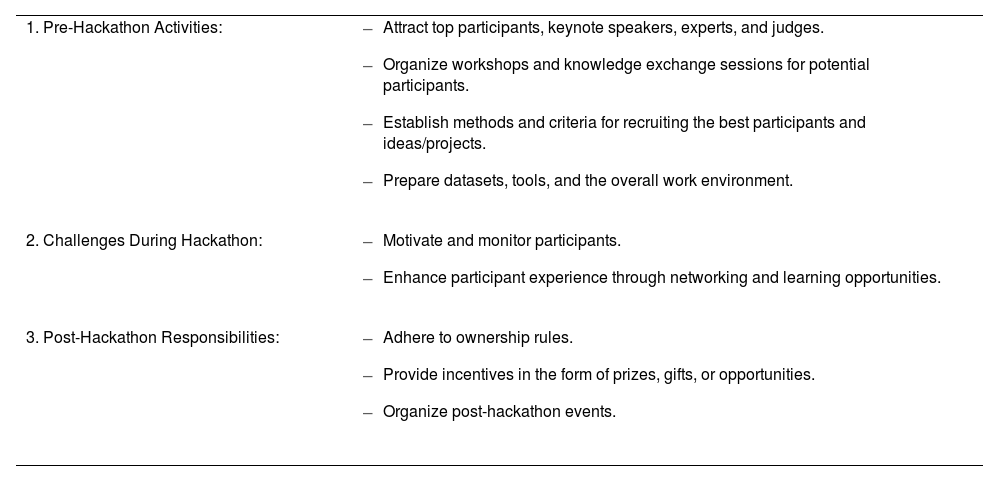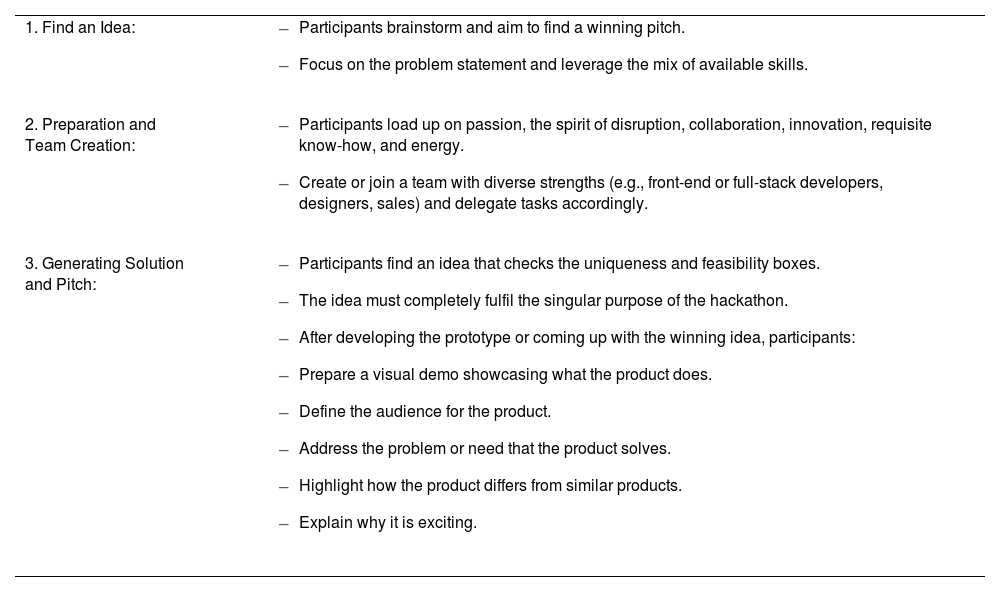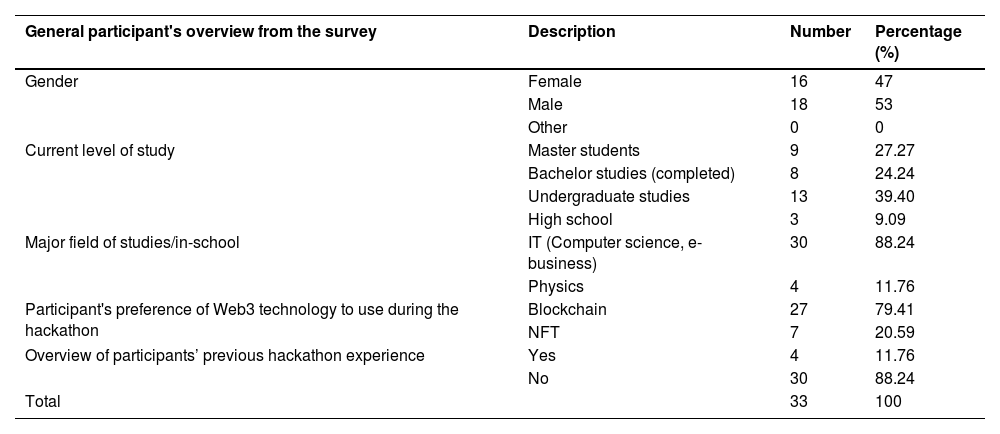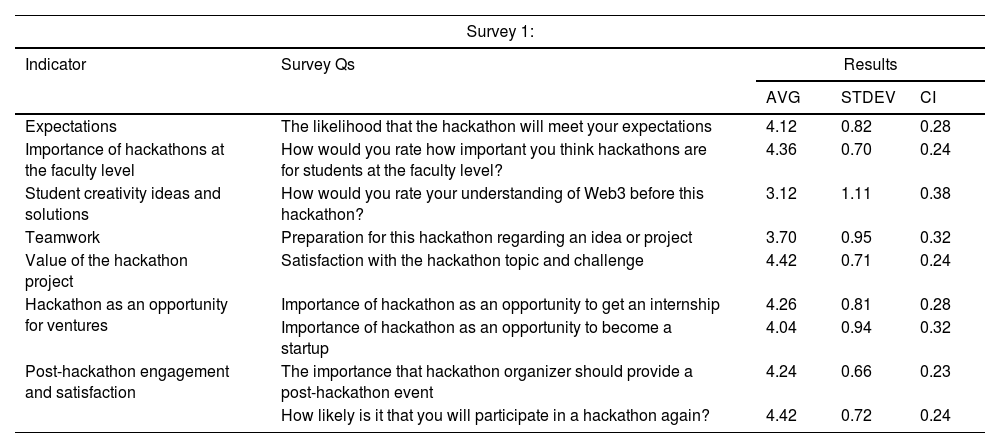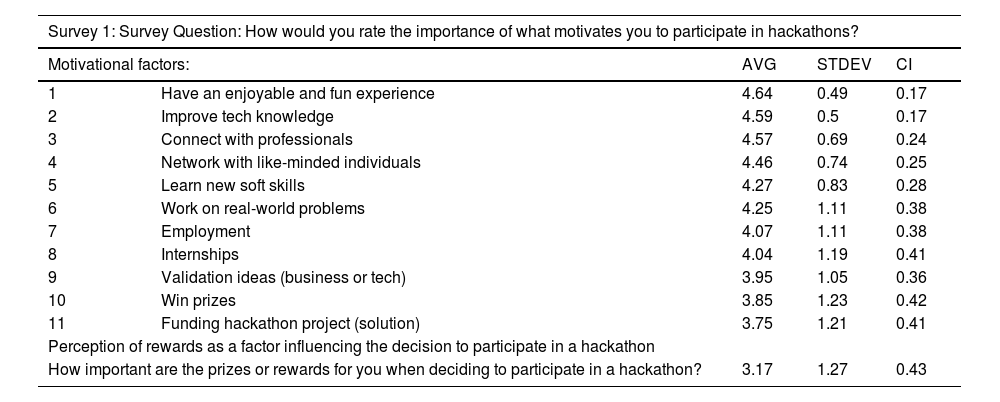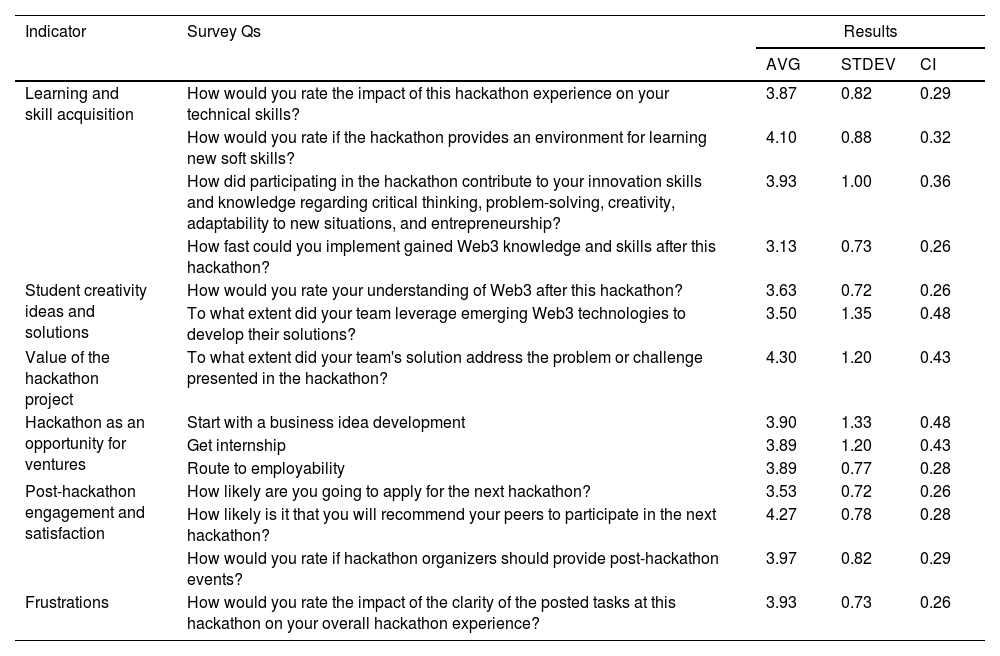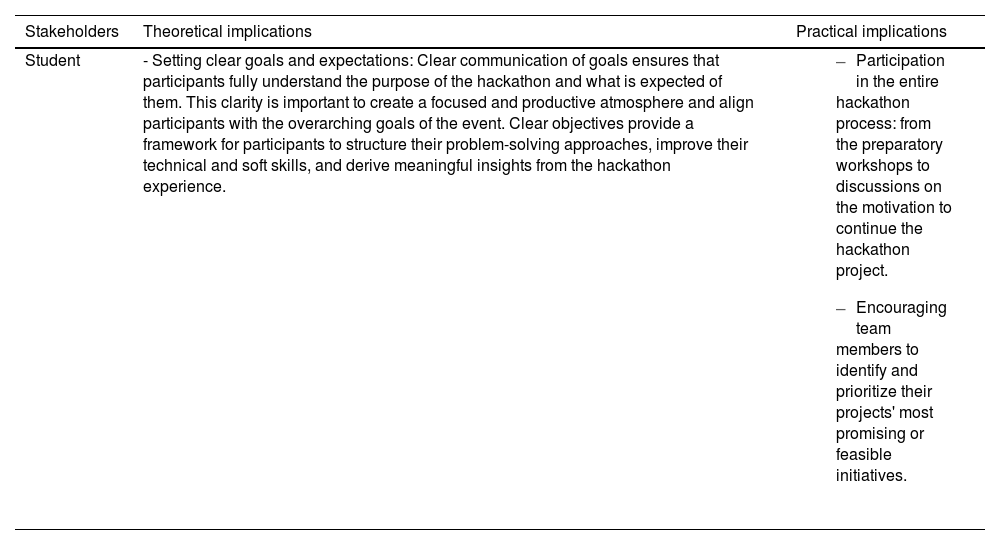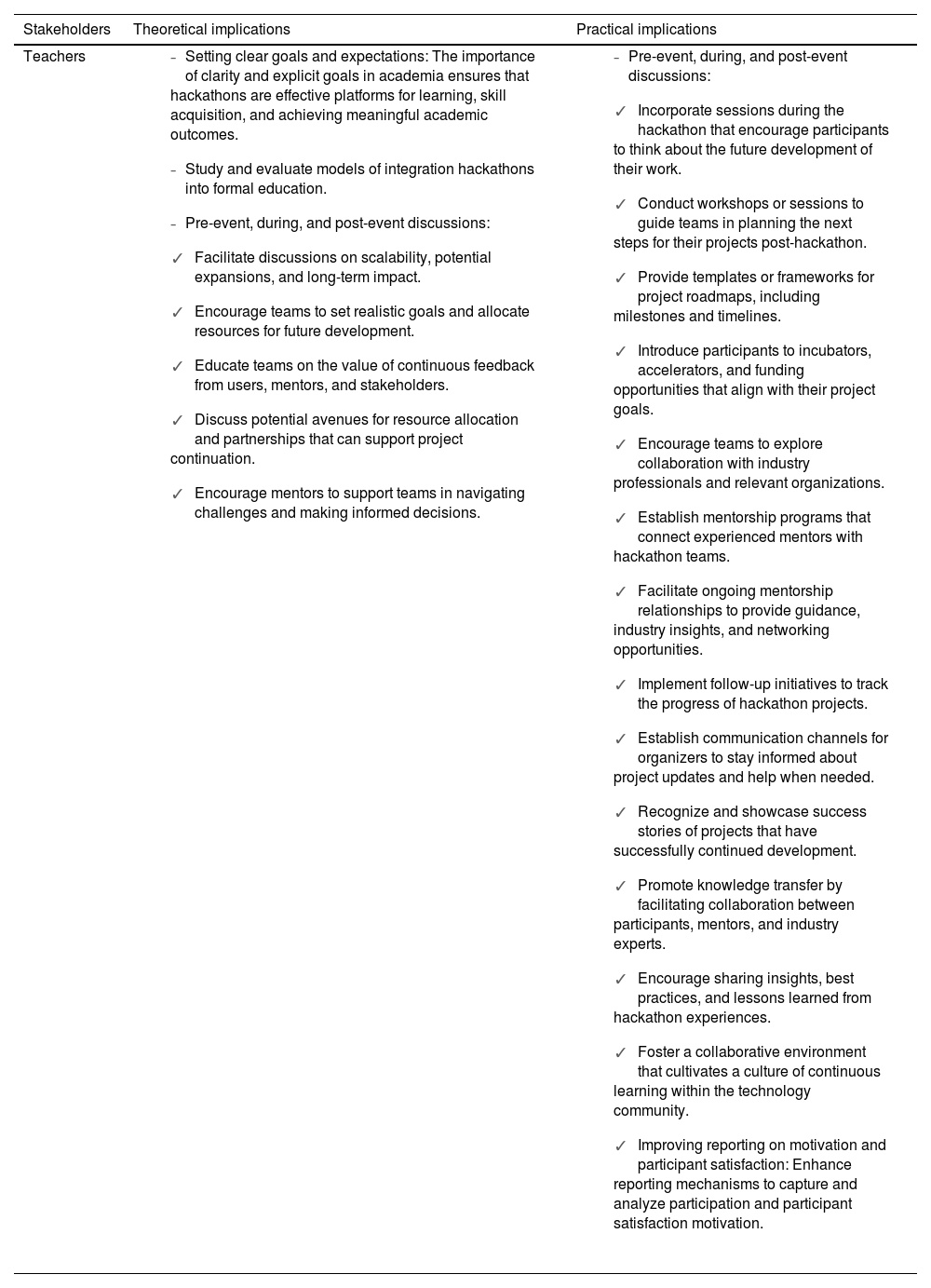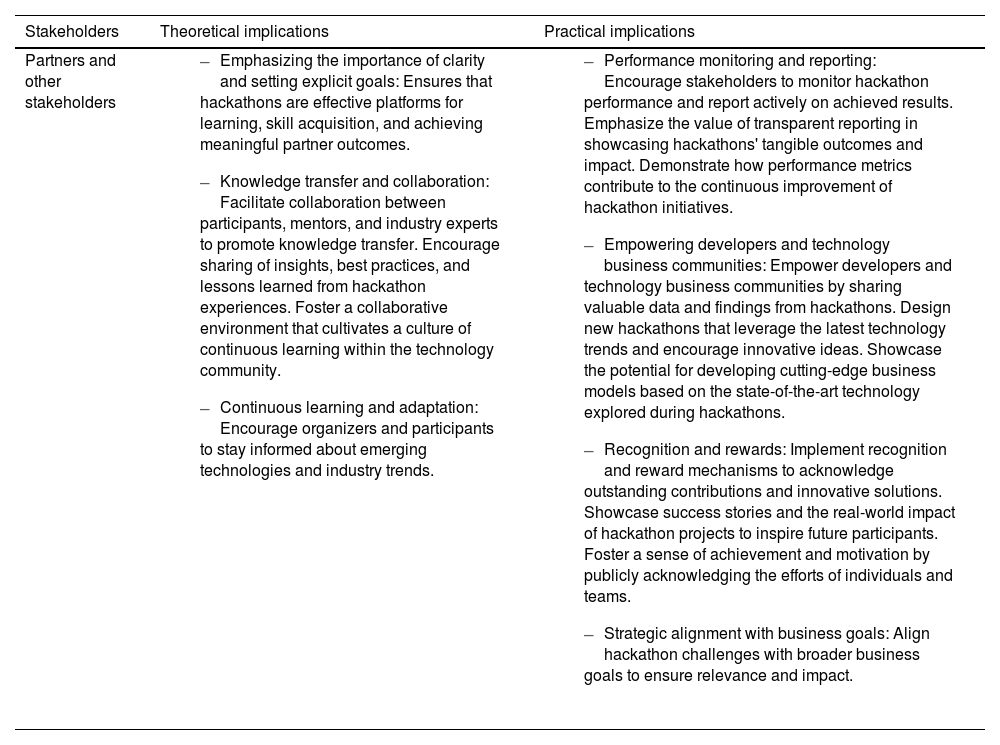The subject of this article is an analysis of the hackathon concept as an educational approach and its role in the development of students' knowledge and skills. The goal is to conduct an in-depth examination of the effectiveness and achievements of the hackathon, with special reference to the attitudes of students and teachers involved in this educational methodology. The key emphasis is placed on participants' perception of the possibilities of hackathons providing long-term results and hackathons' impact as an educational format. Through a specific blockchain hackathon jointly organized by the University of Belgrade, Serbia, and the University of Florida, USA, the research examines participants' perspectives and their expectations, experiences, and overall impressions. The research focuses on the readiness of hackathon participants to incorporate new technical skills through this form of learning, knowledge acquisition, attitudes, and motivational drivers. Furthermore, the research examines how participants' views change before and after the event. The paper contains the insights of educators who, relying on their experiences at the hackathon, emphasize the importance of measuring and monitoring the outcome of the hackathon. Their perspectives highlight the motivation for promoting experimental learning methods in academic settings. This comprehensive research sheds light on multiple impacts of hackathon participation, which extend beyond knowledge acquisition to include changes in technological interests, success in specific domains, and the broader implications of hackathons as a transformative learning experience. The research contributes to the ongoing discussion about innovative approaches to learning. It provides a foundation for a better understanding of how hackathons shape attitudes and contribute to long-term outcomes for both students and teachers, establishing a conceptual framework for hackathon-based learning approaches and opportunities to monitor the effects of hackathons.
Hackathons are often treated as programming competitions, limited in time to a short term, or as competitions for young programmers and developers (Kohne & Wehmeier, 2020; Pe-Than & Mandernach, 2016; Stoltzfus et al., 2017). They can be described as time-based events, short-term software development events, hack fests, or code fests (Nolte et al., 2020; Stoltzfus et al., 2017). Hackathons are a global, widespread phenomenon created for various purposes, such as educational, corporate, civic, and research-focused (Falk et al., 2022). They are recognized as intensive, focused sessions that generate ideas that have originated in programming (Calco & Veeck, 2015).
The inception of hackathons can be traced back to their roots as coding competitions wherein the evaluation primarily revolved around the quality of code. However, owing to their widespread adoption within education and the corporate sector, hackathons have evolved into a format that increasingly extends beyond the traditional timeframes of 24 or 48 h (Kohne & Wehmeier, 2020). Nowadays, the primary emphasis of conducting hackathons has shifted away from mere coding and has transitioned toward developing innovative, sustainable business models and projects utilizing cutting-edge technologies.
In the academic context, hackathons now encompass a broader category, transcending the boundaries of traditional coding competitions and embracing a broader spectrum of applying creative skills and problem-solving activities. There is a discernible trend in formulating hackathon challenges that pivot toward technological phenomena alongside genuine sociological, economic, and political challenges. These thematic orientations align with prevailing insights from analysts, such as those featured in Gartner's & World Economic Forum's Top 10 Emerging Technologies 2023 report, which underscores technologies anticipated to exert a positive societal impact over the forthcoming three to five years (Groombridge, 2022; World Economic Forum, 2023).
Hackathons have become a popular way to foster innovation in education (Garcia, 2023). However, more comprehensive research is needed on their educational role and impact on learning. For example, most hackathons lack a well-defined structure for achieving goals, and there is limited knowledge of the long-term consequences of post-event activities and strategies for sustaining momentum. Another challenge is motivating participants to continue working on their projects after the hackathon. Additionally, monitoring the effectiveness of hackathons is difficult due to the lack of clear criteria for identifying and measuring them. Lastly, effectively communicating the benefits, impact, and significance of participating in hackathons remains a constant challenge (Angarita & Nolte, 2020; Temiz, 2021).
The need for more research is evident in the lack of academic studies on hackathons in education and their sustainable impact on formal and informal education. Although hackathons have gained prominence as platforms for innovation, their potential as pedagogical tools still needs to be explored. There are also considerable gaps in current research on the sustainability of hackathon outcomes. Most research focuses on the sustainability of technical artifacts, while other types of hackathon outcomes still need to be studied. Moreover, many aspects of the design of much of the existing research on hackathons does not explore the outcomes of the hackathon (Stoltzfus et al., 2017). In the context of ensuring the sustainability of hackathon results, elements of hackathon design and implementation have not been sufficiently explored, such as effective communication and demonstration of the benefits, impact, and significance of hackathon participation; motivation of stakeholders to monitor hackathon performance and report on achieved results; and performance monitoring (Bogdanović et al., 2023; Miličević et al., 2023). Despite the abundance of literature and resources dedicated to hackathon design, model orientation, rules, and recommendations for their successful execution, there remains a striking lack of comprehensive studies that deal with the tangible impacts of hackathons on the adoption of specific technical knowledge, such as blockchain technology.
The increasing popularity of hackathons in the educational realm has generated a demand for heightened research attention. Hackathons offer students a valuable platform for networking and establishing connections within the IT industry. When employed as an educational strategy, hackathons emerge as a dynamic approach for equipping students with essential skills and capabilities, enabling them to undertake programming projects and software development. Hackathons are strategically employed across diverse domains, serving corporate and educational objectives. Current hackathon research predominantly focuses on understanding the effective organization and management of these events, developing strategies to cater to diverse participant groups, and orchestrating hackathons beyond software development's scope (Garcia, 2023; Nandi & Mandernach, 2016; Nolte et al., 2018; Seidametova et al., 2022). Recently, more research has been done on hackathon outcomes and participant motivations for these tech-related events (Wallwey et al., 2022).
This article tries to fill gaps in existing hackathon research by illuminating the multifaceted nature of hackathons and their importance in an educational context. It emphasizes hackathons' broader academic and innovation-oriented aspects, such as their potential to improve learning outcomes and innovation. The article aims to contribute to understanding the hackathon effects by measuring and analyzing performance indicators based on a concrete example of a specific hackathon conducted at a university. The goal is to highlight the need for and importance of monitoring hackathon impact indicators by identifying hackathon performance and monitoring hackathon implications for various stakeholders. As such, the research results may serve as a basis for developing a framework to comprehensively monitor hackathon performance and effects.
The structure of the article is as follows. It begins with a detailed literature review, positioning the hackathon as a pedagogical framework for innovation, including design aspects, organization issues, strategies for engaging diverse groups of participants, and methods for articulating the value and impact of hackathon participation. The next section provides details on the methodology used in the research, and the subsequent section presents results from the specific case study W3 Algorand Hackathon 2023 (W3AH’23). The study investigates how the hackathon experience affects technological understanding, willingness to adopt technology such as Web3, motivation to participate in hackathons, and continuation of projects started during the hackathon. The research gathers participants’ insights immediately after the event and four months later, highlighting various impacts of the hackathon, including changes in interests, success in different domains, and improvements in the learning experience.
Literature reviewDespite originating from the technology sector, hackathons have found application in various fields, especially education. According to the results of the hackathon literature review (Garcia, 2023), 249 documents were identified, including 1309 authors, from 180 different sources covering the period from 2014 to 2022. Featured fields include computer science, social sciences, engineering, medicine, and business. Word frequency analysis highlighted "innovation" as the most commonly used word, reflecting innovation as the core goal of most hackathons. In one of the most cited research articles on hackathons (Nolte et al., 2018), it was concluded that hackathons serve as vehicles for informal learning experiences, wherein participants perceived the hackathons as time-constrained events and as conduits for career advancement and knowledge acquisition (Garcia, 2023). Still, despite the growing number of research articles dealing with hackathons, the status of research related to hackathons in education remains to be determined.
Hackathons in educational settingsTo create innovative solutions for identified problems, hackathons can be organized for 2-3 days or more. In some cases, they may be extended with regular meetings that offer insight into the progress of developing solutions. Hackathons can be organized by civil organizations, companies, or academic institutions (Pe-Than et al., 2022). The challenges that hackathons tackle can be targeted or open in scope, with varying collaboration and competition degrees. Although coding is a prevalent focus, hacking events can extend to addressing societal issues, formulating policies, or crafting innovations. Frequently pursued objectives encompass fostering teamwork, nurturing community, and producing concrete results.
Hackathons serve as a pedagogical tool, fostering experiential learning through real-world problem-solving and collaboration in time-constrained events. As a participatory activity, hackathons, akin to other collaborative events, help students learn through hands-on experiences. While studies suggest the adoption of this pedagogy in education, there needs to be more knowledge about the current state of research on educational hackathons. Understanding their status and trends is crucial for informing future research in this emerging field. Trends show a growing interest in educational hackathons until 2021, with the document count peaking in that year at 22.49 %. However, there was a 17.86 % drop in published papers in 2022 (Garcia, 2023). Academic disciplines studying educational hackathons include computer science (57.83 %), social sciences (39.76 %), engineering (24.90 %), medicine (16.47 %), and business (8.43 %).
Globally, private companies lead the organization of hackathon events, hosting 48.5 % of hackathons, while the academic sector is responsible for 30.3 % of these events (HackerEarth, 2017). Hackathons promote collaborative problem-solving, which is crucial across STEAM and social science disciplines to address complex global issues. They serve as dynamic learning environments, utilizing project-based learning to inspire students to creatively integrate diverse knowledge domains through teamwork (Wallwey et al., 2022). Among the prevalent domains and themes, the most prominent is (HackerEarth, 2017):
- –
Multi-discipline hackathons: Participants, including high school and university graduates, collaborate to create captivating concepts using various programming languages, tools, and platforms.
- –
Mobile and web applications development: There has been a rise in popularity of APIs related to payment, geo-location, communication, social networking, and music.
- –
Emerging technologies: The Internet of Things, Machine Learning, Artificial Intelligence, and Augmented Reality/Virtual Reality have emerged as leading domains from 2022 to 2024, signaling their transformative potential across industries.
- –
Cloud computing and data science.
Hackathons and hackathon-inspired activities have gained recognition as pedagogical approaches. Research indicates that a fusion of hackathon-like events can significantly enhance students' motivation, confidence, and comprehension of computing principles and abilities (Byrne et al., 2018). Hackathon methodologies have been widely adopted across various domains, including education, and effectively address challenges in dynamic environments. Educational hackathons employ powerful tools to achieve pedagogical objectives, promoting meaningful interaction, collaborative teamwork, and engagement with diverse collaborators. The integration of multimedia elements and the technology's versatility ensures seamless execution. This approach activates critical competencies, including social, civic, and communication skills, fostering analytical, critical, and inventive thinking. It enhances social partnership aptitudes and cultivates adaptability, essential for personal growth and an enriched quality of life (Kyrychenko & Necherda, 2022).
Hackathons specifically designed for students are accessible to high school students, college students, and recent graduates, and studies have emphasized that creativity has no limits when it comes to age, gender, and race (HackerEarth, 2017; Naumović et al., 2022).
Sections "Hackathons as training programs and mechanisms to boost the growth of the workforce, Hackathons as an environment for producing solutions and generating MVP, Inclusive context of hackathons for women in the IT sector, Hackathons as mechanisms to boost and promote talented students, Hackathons as tools for teaching practical entrepreneurship in academia, Hackathon in the context of interdisciplinary and collaborative aptitudes in creative work settings" provide an overview showcasing how hackathons serve diverse purposes across international and academic settings, each tailored to specific objectives.
Hackathons as training programs and mechanisms to boost the growth of the workforceIn November 2019, 25 student teams convened at Argonne National Laboratory for a cyber competition safeguarding energy infrastructure. Simultaneously, 79 teams assembled at nine other Department of Energy labs. They aimed to develop a training program for upcoming cybersecurity engineers in the energy sector (Feder, 2021). The Physics Department Annual Hackathon at McGill University serves as another example. This 24 h event attracts high school and college-level participants worldwide and aims to encourage innovation and education in fields like quantum computing. By working on solutions and gaining practical experience with real quantum hardware, participants contribute to developing quantum technologies and help cultivate the next generation of researchers and professionals in this cutting-edge field (Feder, 2021). By working on hackathon solutions, participants acquire practical domain knowledge, thereby contributing to the development of the next generation and fostering the growth of a new workforce in these domains. Hackathons serve as a pedagogical method for cultivating skills and competencies essential for preparing students for the workplace (Garcia, 2023).
Hackathons as an environment for producing solutions and generating MVPA hackathon is an environment that facilitates the incubation and generation of Minimum Viable Products (MVP). A study conducted at the Aga Khan University in Pakistan tracked the progress of hacking teams and post-hacking incubation. The teams were tasked with creating a functional digital product, prototype, service, or application along with code that resembled a Minimum Viable Product. They were trained to develop digital products that look like Minimum Viable Products and that can quickly be achieved within two months (Temiz, 2021). In another example of hackathon implementation, students at LUT University in Lappeenranta, Finland are in the function of workforce development as well as the production of hackathon solutions on topics set by local businesses with the aim of preparing the future workforce. Some students’ ideas have been taken into production, and sponsoring companies have hired students. Tech companies have sponsored student hackathons, and students learn content not covered in traditional courses (Feder, 2021).
Inclusive context of hackathons for women in the IT sectorThe potential of hackathons to serve as a targeted tool for fostering greater female participation in the IT industry is exemplified through the experience of Sian Brooke, a doctoral candidate and computational social science fellow at the London School of Economics and Political Science. As part of her PhD research at the University of Oxford, she delved into hackathons to examine how programming culture contributes to hindrances for women entering technology sectors. Her findings reveal that these events are predominantly attended by young, socially reticent Caucasian men who congregate to connect with like-minded peers. This dynamic reinforces the existing demographic in the tech field (Feder, 2021).
Hackathons as mechanisms to boost and promote talented studentsIn Ohio, hackathon-based learning embraces a multidisciplinary approach, motivating students through gamified formats for practical skill acquisition and peer influence (Nandi & Mandernach, 2016). The hackathon aims to spotlight technical talent, cultivate a competitive yet cooperative culture, and foster connections among participants, faculty, and campus resources.
Hackathons as tools for teaching practical entrepreneurship in academiaUK business schools utilize hackathons as practice-based pedagogical tools to teach practical entrepreneurial skills. One study (Avila-Merino, 2019) addresses the limited exploration of hackathons' role in entrepreneurial learning at universities, particularly in the UK. Entrepreneurial skills receive limited emphasis in UK universities. Hackathons, integrating theory into entrepreneurship education, serve as catalysts for practice-oriented modules. Employing hackathons in teaching enhances student engagement and leads to improved post-graduation outcomes, including access to higher-paying jobs, smoother professional growth, and essential entrepreneurial competencies (Avila-Merino, 2019). The hackathon showcased its value as a learning tool in this context, boosting participants' employability, entrepreneurial skills, and understanding of interdisciplinary collaboration (Surendran et al., 2023).
Hackathon in the context of interdisciplinary and collaborative aptitudes in creative work settingsHackathons are progressively harnessed to address issues, foster product innovation, and, most notably, instigate inventiveness, original thinking, and inventive prowess. Illustratively, the Markathon project employs the hackathon framework to introduce students to an immersive learning structure that leverages the marketing principles they have assimilated over the academic term. Through this approach, students fortify their comprehension of marketing concepts and gain exposure to diverse proficiencies encompassing problem-solving, analytical acumen, and effective verbal and written communication. They cultivate collaborative aptitudes through practical team-oriented engagement (Calco & Veeck, 2015).
Hackathon design and organizationThe success of a hackathon is influenced by a range of design elements such as its name, date, duration, initiator's sector and type, objectives, driving factors, themes, format, participant count, gender balance, team creation, participant skill sets, problem definition, idea generation, and prize structure (Pe-Than et al., 2018). Notably, the inclusivity of participants and the level of openness play a significant role in fostering a diverse array of ideas and effective problem-solving. These factors collectively contribute to the overall richness of the hackathon experience (Temiz, 2021). When orchestrating a hackathon, organizers must consider many factors, including the event's theme, the selection of participants, the choice of venue, the methods for team arrangement once the hackathon commences, and strategies for post-event activities (Nolte et al., 2020). The general procedure of conducting hackathon events involves three phases (Garcia, 2023; Kohne & Wehmeier, 2020):
- 1.
Preparation, where a detailed plan of the actual hackathon is drawn up;
- 2.
Operation, which signifies the actual event; and
- 3.
Follow-up, which transfers valid ideas to actual product development.
Strategic planning for hackathons should extend to post-event projects and processes. Maintaining year-round connections between individuals and private/public entities requires user-friendly technology platforms. Organizations face challenges leveraging hackathon outcomes, with private entities showing quicker engagement than public institutions (Temiz, 2021). The scope of work by hackathon organization and realization is quite diverse. The hackathons may include brainstorming sessions on new concepts, platforms to foster innovation, media to construct working prototypes, etc. There can be multiple goals in cases where hackathons are participant-driven, such as identifying and acquiring top talent, actively engaging the workforce, or fostering a cohesive community. In contrast, hackathons with a results-oriented focus can be strategically designed to develop intellectual property, strengthen brand recognition, or catalyze innovation. Common goals of results-oriented hackathons can be perceived, such as (HackerEarth, 2017): exploring new technologies, branding, driving business innovation, creating solutions for social causes, sourcing incubation programs, analyzing data to make predictions, creating potential startups, and rewarding innovative thinking.
Designing a hackathon involves planning and considering the goals that the organizers and participants set for the event and themselves. The general route in the hackathon design process from the organizer's and participant's perspectives is presented in Tables 1. and 2. (HackerEarth, 2017). This organized approach ensures clarity and a systematic flow of activities for successful hackathon planning and execution.
Hackathon designing process from an organizer's perspective – Event Flow.
Hackathon designing process from a participant's perspective.
Preparations for a hackathon should start a few months before the scheduled event. Organizers should collect data at specific points before, during, and after the hackathon. Extensive data collection includes interviews, observations, and questionnaires regarding design aspects from the perspective of organizers and participants. During the hackathon process, data is collected from the organizers and the participants, most often to examine team dynamics, motivation for participation and teamwork, preparation for participation, and interest in project topics and technologies. Immediately after the hackathon, data is collected from the participants about the experience gained during the participation, starting with motivation; potential activities that they carried out before the hackathon; their satisfaction with the outcome and the way the outcome was achieved; achieved learning outcomes; connecting with new people; and opportunities for career advancement (Avila-Merino, 2019; Falk et al., 2022). Data is also collected after the hackathon to assess the status of their hackathon projects. These aspects can serve as a starting point for developing theory on the continuation of hackathon projects (Falk et al., 2022; Kohne & Wehmeier, 2020) and how to design hackathons for efficiency (Avila-Merino, 2019). Continuous monitoring of the state of the results and teams after the hackathon motivates participants and organizers to work on improving the environment, helps the sustainability of hackathon projects or teams, and sets the environment for hackathon performance measuring (Miličević et al., 2023).
Generally, the after-effects are measured by interviews or surveys, in which participants are asked about their satisfaction, the level of achieved technical knowledge, experience, etc. The given insights do not bring more profound recommendations for what to do after the hackathon and how to provide the conditions and incentives for the motivation of the organizers and participants to continue the projects after the hackathon (Asiedu et al., 2020; Briscoe & Mulligan, 2014; Butt et al., 2021; Čović & Manojlović, 2019; Falk et al., 2022; Angarita & Nolte, 2020; Nolte et al., 2018). There are documented strategies to maintain a hackathon's outcomes beyond its conclusion. To illustrate, for the enduring advancement of technical creations originating from a hackathon, organizers have implemented measures such as providing coaching and mentorship to winning teams, presenting displays of the technical innovations generated at subsequent gatherings, awarding post-hackathon prizes, launching finalized versions of the technical creations, expanding teams through new recruitments, and pursuing grant opportunities. Nevertheless, limited insights are available regarding the lasting effects of these post-hackathon endeavors on the sustained viability of the outcomes (Angarita & Nolte, 2020). Continuation intentions might be directed at different follow-up activities, including technical continuation activities and activities related to expanding the reach of a project by attracting funding. Follow-up actions may include creating different forms of communication (such as blog posts, posters, or meeting presentations), assembling a team to take the project further, or seeking financial support. The likelihood of success increases when these side ventures align with the participants’ ongoing professional goals and yield short-term benefits. There is no fixed formula for additional activities. The organizers can be given the following recommendations (Stoltzfus et al., 2017):
- –
During the event, encourage participants to consider the future development of their work.
- –
Discuss potential next steps in the closing activities on the last day.
- –
Engage each team in post-event discussions about the most promising or feasible initiatives.
- –
Discuss the basic requirements to ensure ongoing project continuity with each team.
The impetus to sustain hackathons gains strength from nurturing a competitive and collaborative culture, providing a platform for adept individuals to exhibit their expertise. Instances abound where those who organize hackathons (including educational institutions and faculties) and partnering companies offer significant advantages to students, driving students’ motivation and deeper involvement in hackathon initiatives. These benefits include securing internships or employment opportunities, utilizing hackathons as a talent pool for recruiting students into specific research roles, establishing valuable mentorship connections with alumni, and opting to engage in projects recommended by the staff. Additionally, these events facilitate participants in connecting with faculty members, campus labs and centers, and, most crucially, with one another (Angarita & Nolte, 2020; Pe-Than et al., 2018, 2022; Seidametova et al., 2022); sponsoring students to attend other hackathons and funding-related events; and soliciting more significant partnerships with industry. These initiatives foster an inclusive tech culture focused on informal learning (both individual and peer-based) and higher levels of engagement with the technology industry (Falk et al., 2022; Nandi & Mandernach, 2016; Pe-Than et al., 2018).
While there is some debate about rewards potentially turning hackathons into competitions or cases of corporate exploitation and ruining the experience, they still serve as motivating factors for participants. Interestingly, mentorship, investor, and accelerator/incubator opportunities were the most popular forms of compensation at the hackathons previously referenced. Student hackathons have been more about learning and innovative thinking than cash prizes and sophisticated gadgets. This indicates that the current culture in academia emphasizes outside-the-box thinking, allowing students to network and learn. Universities prefer encouraging learning rather than offering monetary rewards (Nolte et al., 2018). Hackathons encourage participants to change perspectives and influence, raising interest in sustainability and development (Surendran et al., 2023).
In addition to product innovation, hackathons can be used with great success to enrich networks within the company and prepare employees for future changes and positions (Pe-Than et al., 2018). The approach of cooperation between the organizers and partners enables mutual sharing in the creation and use of the benefits of the hackathon, gaining a comprehensive understanding of the broader impact of the hackathon, both locally and globally.
Based on previous analysis, there is a growing need for educators and teaching staff to understand how to better exploit the pedagogical potential of hackathons. Hackathons allow teachers to focus on collaborative team teaching, active and participatory learning, and innovative approaches to developing important transversal skills. Although the impact of hackathons still needs to be explained in research literature, the demand for this curricular innovation is growing. Hackathons are a challenge to embed in the curriculum and are simultaneously part of the "next normal" university experience (Lionaite, 2020; Lyons et al., 2021). In the next section, we present the methodological approach used in this research to address the aspects of students' motivation and new technology acceptance for hackathon purposes, post-hackathon effects, and teachers' perspectives on this learning model.
Methodology and materialsResearch questions and contextParticipants' and teachers' general attitudes toward the hackathon were examined during the research. The following research questions were formulated:
- –
RQ1: To what extent are hackathon participants willing to adopt new technical knowledge, specifically Web3 and blockchain, through hackathon-based learning?
- –
RQ2: What are the main motivation drivers of hackathon participation?
- –
RQ3: What are participants' post-hackathon effects and attitudes regarding learning and professional development?
- –
RQ4: How do teachers perceive hackathon-based learning, its impact on student knowledge and experience, teaching methods, and their own experiences when participating in hackathons?
The context of this research question was the international hackathon W3AH'23, organized and hosted at the University of Belgrade - Faculty of Organizational Sciences and the Blockchain Lab, University of Florida, in April 2023. The Algorand Foundation sponsored the event. This event attracted participants from both the USA and Serbia. W3AH'23 was a chance for students to create innovative Web3 projects based on blockchain technologies on the Algorand platform. Projects proposed new e-business ecosystems, models, and software (for health, education, industry, banking, commerce, smart cities, etc.).
The event followed a program from March 1 to April 31, 2023. Students attended a four-week blockchain bootcamp, learning blockchain programming on the Algorand platform and participating in product development and design-thinking workshops. They then had four more weeks to work with mentors. Finally, students presented their results to an international jury and were awarded various prizes from sponsors.
Data collection and survey instrument structureThe data was collected in two stages:
- –
Initial data collection immediately after the hackathon (Stage 1).
- –
Four months after the hackathon (Stage 2), data was collected involving participants and organizers (teaching staff).
The process of collecting data is illustrated in Table 3 and Fig. 1. Three questionnaires were created: the participants' survey, the participants' post-hackathon survey, and the questionnaire for teaching staff at the hackathon. The first questionnaire was administered to participants in the initial phase immediately after the conclusion of the hackathon. In contrast, the second and third questionnaires were administered separately in the second phase, four months after the hackathon, among participants and teachers.
Survey 1: This questionnaire was utilized in the initial phase. It consisted of seven sections, each related to the selected performance indicator and followed by relevant questions:
- (1)
General participant overview: This section captures participants' demographic information, expectations, and goals regarding participants' previous experiences and the likelihood of their expectations being met.
- (2)
Student creativity, ideas, and solutions: This section examines participants' attitudes concerning their prior comprehension and experience applying blockchain technology.
- (3)
Teamwork: Participants' attitudes and perspectives on how team composition influences group dynamics.
- (4)
Value of the Hackathon Project: Participants' contentment with the hackathon experience, including challenges and solutions.
- (5)
Hackathon as an opportunity for ventures: Participants' perceptions regarding hackathons as pathways to careers, including startups, internships, and professional opportunities.
- (6)
Motivation to engage and repeat participation: Participants' reasons for joining the hackathon.
- (7)
Post-hackathon engagement and satisfaction: Participants' engagement with events following the hackathon and their level of satisfaction with these activities.
Survey 2: This questionnaire was created to collect data on the perspectives and insights of the participants four months after the hackathon's conclusion. Eight sections, i.e. performance indicators, of the survey were:
- (1)
Comprehensive participant overview: This section presents comprehensive demographic information from participants (gender, selected Web3 technology, and whether they participated in preparatory workshops). This section looks at the transformations observed in participants as a result of participating in the hackathon.
- (2)
Learning and skill acquisition: This section investigates the influence of the hackathon on the adept adoption of novel technologies, familiarity with blockchain technology, enhancement of soft skills, problem-solving capabilities, and related competencies.
- (3)
Ideas and solutions for student creativity: Participants' attitudes towards the extent of their comprehension and experience in applying blockchain technology within hackathon solutions.
- (4)
Value of the hackathon project (Teamwork on Hackathon Challenge): Insights into participants' perceptions of their teamwork experience while tackling the hackathon challenge and their subsequent dedication to advancing work on the hackathon project.
- (5)
Satisfaction with hackathon experience (Motivation): Participants' attitudes concerning their motivation, post-hackathon participation, and the garnered experiential knowledge.
- (6)
Hackathon as an Opportunity for Ventures: Participants' post-hackathon perceptions of hackathons as platforms for cultivating business ideas, securing internships/apprenticeships, and exploring professional opportunities.
- (7)
Post-event engagement: This section concurrently assesses participants' satisfaction with post-hackathon activities.
- (8)
Challenges and frustrations: The final set of questions aims to unearth potential adverse effects of hackathon participation, such as a fast-paced and dynamic work environment, challenges from hackathon regulations, discomfort within team dynamics, and any shortcomings observed in lectures or mentorship that may have hindered team performance and led to unmet expectations.
Survey 3: Teachers who participated in the organization and execution of the bootcamp and hackathon were given this questionnaire specifically designed to explore and analyze educators' perspectives regarding the hackathon-based learning format. To identify the domains where a hackathon holds an advantage as an informal learning method, the following aspects were included:
- –
Cultivating students' creativity and problem-solving approaches.
- –
Enhancing specific knowledge.
- –
Polishing "soft" skills.
- –
Fostering the development of an entrepreneurial spirit and appropriate conduct in students.
- –
Elevating the general quality of solutions.
The questionnaire further addressed the hackathon's implications for teaching staff, particularly their receptivity to adopting the hackathon as an educational tool. In addition, the questionnaire aimed to assess teachers' propensity to improve their pedagogical approaches and teaching methodologies and to determine their active participation in the professional community.
Participants33 students (hackathon participants) filled out the first questionnaire immediately after the hackathon. Table 4 provides a description of the research participants.
Research participants in Survey 1.
In Survey 2, 30 hackathon participants from Serbia completed the questionnaire four months after the final hackathon. Survey 3 was conducted specifically for the hackathon organizers and the Faculty of Organizational Sciences teaching staff.
ResultsRQ1: willingness to adopt new technical knowledgeTable 5 shows the results of the data analysis from Survey 1, which examined the hackathon participants' willingness to adopt new technical knowledge related to Web3 and blockchain through hackathon-based learning.
Results of Survey 1.
The results show that 88.24 % of participants had no experience with Web3 and blockchain technology. The highly rated likelihood of expectation fulfillment indicates that the hackathon participants had high expectations from participating in the hackathon (rate 4.12). This demonstrates that they believed that they would get personal benefits by participating in the hackathon. Additionally, they emphasized the importance of the hackathon as a faculty work format (rate 4.36). Participants were highly prepared for engagement in the hackathon. Participants highly rated their satisfaction regarding the hackathon's topic of Web3 technology (rate 4.42). The participants considered the hackathon a crucial way to gain opportunities for practice and internship and learn how to become a startup. The likelihood that they would repeat their participation in the next hackathon was expressed through a high score of 4.42. Additionally, the participants pointed out that the organizers should enable post-hackathon events.
RQ2: motivation drivers of hackathon participationIn this part of the research, we specifically focused on examining the factors that influence the motivation of participants to join and repeat participation in the next hackathon, as well as the rewards that encourage the students to join the hackathon. According to the results, they can be ranked from the most important to the least important (Table 6). In this sense, 11 possible drivers of motivation were analyzed, and the participants expressed their opinions about each motivational factor. The following factors were perceived and recognized as the most valuable: having enjoyable and fun experiences, improving tech knowledge, and connecting with professionals. Winning prizes, opportunities for validation ideas (business or tech), and funding hackathon projects (solution) were rated lowest.
Participants' views on the motivational and rewarding aspects of participation in the hackathon.
The expressed views regarding the awards suggest that the rewards are essential but not at the level that is usually assumed. This may be due to the educational context of the hackathon.
RQ3: post-hackathon effects and attitudes of participants regarding learning and professional developmentResults of Survey 2 show the attitudes of hackathon participants related to the post-hackathon effects and attitudes regarding learning and professional development (Table 7).
Results of Survey 2.
Regarding the extent to which the hackathon experience affected technical and innovation skills, participants expressed their opinion with moderately high values (3.87 and 3.93, respectively). However, learning new soft skills was rated higher (4.10). After evaluating how quickly they could apply the acquired Web3 knowledge after this hackathon, the participants thought the pace was moderate with noticeable progress. In addition, participants indicated that after the hackathon, they estimated their understanding of Web3 to be at an intermediate level.
Regarding the opportunities for professional career development, all aspects considered received a rating below 4. However, participants expressed high enthusiasm and willingness to recommend the hackathon to their peers, leading to the conclusion that they highly value the overall benefits of the experience. However, the clarity of the goals set at the hackathon greatly impacts the overall experience, thereby affecting the frustration among the participants, such as discomfort due to misunderstanding the goals.
The participants' views on the assessment of motivational triggers four months after the end of the hackathon are shown in Table 8. Notably, acquiring knowledge is still a more important motivator than rewards.
A specific segment of the research was devoted to analyzing the participants' views about the significant changes in their lives during the period that passed from the end of the hackathon to the second survey, which took place four months later (Table 9).
What changed in the life of the participants after the hackathon ended.
In this context, the aim was to identify the extent to which students remained engaged or interested in Web3 technology and whether and when they shifted their orientations and interests. Only a few participants got a job related to Web3 technology, which is still a good result, keeping in mind the share of available Web3 jobs in IT markets. It is encouraging that many have maintained an interest in Web3 technology despite their current employment status.
Several notable trends emerge in comparing the research findings concerning participants' attitudes just after the hackathon with perspectives collected four months post-hackathon. Results are presented in Table 10.
Comparative findings from Survey 1 and Survey 2.
Most scores obtained in the latter assessment are lower than those observed in the initial research. One noteworthy deviation is the participants' assessment of their understanding of Web3 technology, which has increased (from 3.12 to 3.63), confirming the value of hackathons regarding technical skills. However, the rating of the hackathon as an opportunity for finding an internship has decreased, most likely due to the fact that a lower number of participants got an internship. Furthermore, it is almost universally acknowledged that hackathons are suitable for startups, while the rating of the likelihood of participants applying again has declined from 4.42 to 3.53. The importance of organizers providing post-hackathon events still holds significant weight, and the emphasis on awards remains, although it has decreased.
RQ4: teachers’ perspectives on hackathon-based learningAn analysis of teachers' perspectives was conducted in the third segment of this research (Survey 3). These insights delve into how teachers perceive hackathon-based learning, its influence on students' knowledge and experiences, and the implications for teaching methodologies. Within this context, the teaching staff assessed the quality of the solutions presented at the hackathon with an average rating of 4.50. This rating reflects their evaluation of the innovativeness of the proposed solutions. Moreover, the progress made by students during the hackathon received a rating of 4.00, indicating substantial advancement.
Additionally, the impact of students' engagement in the hackathon on their personal development and future academic achievements garnered a rating of 4.17, signifying a positive effect of the hackathon on students' future academic accomplishments. Teachers with the highest rating of 5.00 emphasized that hackathons offer valuable opportunities for both students and teachers to expand their networks and gain visibility in non-academic settings. Furthermore, teachers highlighted that hackathons play a pivotal role in inspiring educators to enhance their teaching methods and incorporate experiential learning approaches. They underscored the importance of ongoing assessment of hackathon outcomes and their impact on the development of students' knowledge and experiences, as well as their influence on teachers' professional growth. As per the research findings and the collective insights derived from the teaching staff concerning the modality of activities akin to hackathons, the following aspects of learning are favored:
- a.
The hackathon format can nurture students' creativity and enhance their problem-solving capabilities.
- b.
Hackathons are seen as conducive to fostering and enhancing students' entrepreneurial mindsets and behaviors.
- c.
The hackathon format is considered appropriate for promoting the development of high-quality solutions.
Hackathons maintain their foundational focus on technological innovations. These innovations align with the latest trends in technological advancements, as emerging technologies can catalyze transformative changes within industries, stimulate economic growth, enhance the quality of life, and contribute to environmental sustainability when engineered, scaled, and applied responsibly (World Economic Forum, 2023). Solutions developed at hackathons can contribute to solving detected problems in diverse industries. This extended engagement catalyzes fostering creativity, promoting problem-solving, and facilitating the implementation of advanced technical enhancements utilizing state-of-the-art technologies, all while delivering a viable business concept as a solution. Hackathons entail the development of holistic solution concepts, wherein the central objective involves the creation of technology-driven solutions capable of addressing challenges associated with technology-based products and services, yielding substantial business outcomes and ramifications in a comprehensive context.
This section presents the theoretical and practical benefits and implications of hackathons for students and teachers, the post-hackathon events' role in the entire project, and implications for partners and other stakeholders. Also, we discuss motivational drivers and opportunities that hackathons provide for startup orientation, internships, and career development.
ImplicationsHackathons are widely recognized as a valuable mechanism for acquiring technical knowledge. These events are focused on software and hardware development, either using specific technologies or creating software prototypes (Falk et al., 2022). The outcomes of hackathons can be classified into tangible and intangible deliverables. Tangible deliverables encompass technical artifacts related to new prototypes, product features, and bug fixes. Intangible deliverables signify acquiring knowledge about emerging technologies (Angarita & Nolte, 2020).
Theoretical and practical benefits for studentsFrom the students’ perspective, hackathons are increasingly being used in creative work environments to solve problems and create new products, and even more importantly, to inspire originality, creativity, and innovativeness and as mechanisms for learning new tools or skills (Nolte et al., 2018). There are many approaches to the implementation of hackathons, and they can be used to teach students the necessary skills and competencies for various fields, mainly software development (Seidametova et al., 2022), but other areas as well (Calco & Veeck, 2015).
Within this research paper, the outcomes detailed under the Learning and skill acquisition indicator demonstrate that participants highly appraised the hackathon environment as conducive to acquiring technical and soft skills. The hackathon has been recognized as an effective mechanism for adopting new technologies and IT knowledge. At the beginning of the event, participants rated their understanding of Web3 technology as average (3.12), as indicated by the criteria of Student creativity, ideas, and solutions. Four months later, when re-evaluating the same indicator, participants rated their understanding of Web3 technology higher (3.63). Additionally, the hackathon significantly enhanced participants' overall innovation skills and knowledge, encompassing critical thinking, problem-solving, creativity, adaptability to new situations, and entrepreneurship. Based on the observed indicator of the section Value of the hackathon project, which is reflected in students' attitudes toward their satisfaction with the given topic and tasks, the results indicate that the participants highly rated their satisfaction with the topic and tasks of the hackathon.
Table 11 shows theoretical and practical implications for students.
Theoretical and practical implications for students.
The field of education is progressively adopting time-constrained collaborative events to provide students with practical, experiential learning opportunities (Byrne et al., 2018). Based on the research findings and insights from teaching staff regarding the benefits of learning in the hackathon format, teachers pointed out that the hackathon effectively fosters students' creativity and improves their problem-solving skills. Teachers underscored the pivotal role of hackathons in inspiring educators to improve their teaching methods and integrate experiential learning approaches.
Regarding the indicators Research the new pedagogical approach and Experiential learning outcomes, teachers emphasized the great importance of innovation in student solutions, giving it a score of 5.00.
Teachers who actively participated in hackathons consider this participation significant, which motivates them to improve teaching methods and experiential learning.
Table 12 shows theoretical and practical implications for teachers.
Theoretical and practical implications for teachers.
A crucial determinant of hackathon success lies in the post-hackathon events and opportunities offered to participants by organizers and partners. It has been underscored that organizations often need to prepare to leverage hackathons' outcomes (Temiz, 2021) effectively. Continuation intentions might be directed at different follow-up activities, including technical continuation activities and activities related to expanding the reach of a project by attracting funding. Follow-up actions may include creating other forms of communication, assembling a team to take the project further, or seeking financial support (Angarita & Nolte, 2020). There is no formula for successfully implementing post-hackathon activities (Calco & Veeck, 2015).
Post-hackathon events play a pivotal role in influencing the continuity of hackathon projects. These events may include various incentives such as cash prizes, opportunities to develop winning ideas further, the provision of additional resources, and the allocation of time for participants to continue working on their projects after the hackathon concludes. Additionally, the chance to present ideas to a specific audience and attract attention and potential funding opportunities further contributes to the sustained momentum and development of projects beyond the hackathon event. These post-hackathon elements recognize and reward participants' efforts and serve as catalysts for the ongoing success and evolution of innovative ideas generated during the hackathon.
It has been emphasized that careful planning and preparation for post-hackathon opportunities are crucial, especially for teams identified with additional potential for further development of their hackathon projects. However, organizers often found themselves unprepared for the post-hackathon aspects of the event. In this research paper, findings from survey results indicate that participants consistently view post-hackathon engagement as necessary and important, significantly influencing overall hackathon satisfaction. The post-hackathon engagement and satisfaction assessment involved participants' perspectives on the significance of organizers providing post-hackathon events and the likelihood of participants applying for subsequent hackathons. In the initial evaluation, participants highly valued the importance of post-hackathon events and expressed a strong inclination to apply for the next hackathon (rated 4.42 and 4.24.). However, in the follow-up evaluation four months later, both criteria received lower ratings, indicating a shift in attitudes over time. The importance of post-hackathon events was still considered significant but slightly diminished (at 3.97), and the likelihood of applying for the next hackathon slightly decreased (to 3.53). Therefore, extending the plan beyond the hackathon is recommended, establishing channels for ongoing collaboration, linking teams with investors, and promoting continued efforts (Pe-Than et al., 2022).
Table 13 shows theoretical and practical implications for partners and other stakeholders.
Theoretical and practical implications for partners and other stakeholders.
Participants commonly attend hackathons based on individual motivations such as having fun or learning (Angarita & Nolte, 2020). Students acquire the ability to condense their development process within a limited timeframe, enabling them to refine their problem-solving, project management, and prioritization skills. They gain a vibrant, enjoyable, and immersive learning experience (Nandi & Mandernach, 2016).
Hackathons provide students an opportunity to meet and create new links in the IT industry (Pe-Than et al., 2018; Seidametova et al., 2022). Researchers discovered common goals, such as networking and learning, when investigating the alignment of goals between hackathon planners and participants (Angarita & Nolte, 2020).
This research paper delves into the factors shaping participant motivation and involvement in hackathons, explicitly examining the role of rewards as motivational stimuli. Noteworthy factors, including pursuing positive and enjoyable experiences, the opportunity for technological skill advancement, and networking with professionals, are particularly valuable. Among these factors, pursuing positive and enjoyable experiences stands out, with the highest rating of 4.64. While the importance of rewards is recognized, their impact is less substantial than commonly assumed. The principal drivers of motivation continue to be positive experiences, technical learning, and professional networking. The perceived significance of rewards implies a neutral to moderately vital influence on participant attitudes, emphasizing their persistent relevance in decision-making. According to participant evaluation, the motivational factors can be ranked in the following order:
- 1.
Have an enjoyable and fun experience.
- 2.
Improve tech knowledge.
- 3.
Connect with professionals.
- 4.
Network with like-minded individuals.
- 5.
Learn new soft skills.
- 6.
Work on real-world problems.
- 7.
Employment.
- 8.
Internships.
- 9.
Validation ideas (business or tech).
- 10.
Win prizes.
- 11.
Funding hackathon project (solution).
The significance of rewards and winning prizes decreases over time.
OpportunityFor participants in a hackathon, there are various goals to consider, especially regarding business and startup potential. One of the primary objectives could be to build a network of contacts. Some participants are eager to start their businesses and see it as a career opportunity. In contrast, others may want to gain experience and establish connections before starting a startup. Additionally, some may view hackathons as an opportunity to gain valuable experience that could be useful for pursuing a career in a corporate environment or to apply and test their skills in practice.
As a route to startupIt is generally accepted that hackathons are suitable for startups. Good examples show that a hackathon could serve as an environment for incubating startups and creating an MVP (Feder, 2021; Temiz, 2021) and as a tool for teaching practical entrepreneurship in academia (Avila-Merino, 2019). Hackathons with a primary goal of creating an MVP have a place in the corporate setting or environment (Nolte et al., 2018); in this regard, hackathon projects must be investor-ready (Calco & Veeck, 2015).
With examples of external practice from the literature and internal experiences of the implemented Web3 hackathon, we can discuss whether the hackathon is an opportunity for a startup. It depends on the hackathon's design, especially its theme, the challenge set, and the goals for all stakeholders.
Hackathons are designed to create solutions that are applicable and sustainable. This means that they provide an environment that inspires business thinking and ideas by validating assumptions about the functioning of the solution idea in the pre-incubation and early development stages of a business. Hackathons encourage participants to adopt an entrepreneurial mindset and learn about startup principles. However, additional programs, mentorships, and incubation interventions unrelated to the hackathon may be necessary for a more profound and realistic development of startup ideas.
According to the research results, the hackathon was rated an essential opportunity for the teams to develop business ideas. The teachers also pointed out that the hackathon is a learning format suitable for fostering and improving students' entrepreneurial thinking and behavior. In the concrete example of the hackathon that was conducted at the university, the hackathon solution for the given challenge was created in "closed conditions" without insight into the real market and user testing. However, the hackathon served as a valuable learning environment and platform for simulating the proposed business solution. It helped participants understand how to create products and services based on a particular technology.
The indicators Hackathons as an opportunity for ventures and The importance of hackathons as conception to become a startup were evaluated as important for developing business ideas and starting a venture. The results showed that these indicators stayed mostly the same, decreasing only slightly from the beginning of the hackathon to four months later.
Hackathon as an opportunity for internshipIn environments where hackathons do not aim to build prototypes and MVPs, hackathons primarily provide learning, introduce participants to new technologies, and familiarize them with technology application potentials and practical examples. This contributes to the improvement or development of a set of fresh soft skills, such as team communication skills, team management, sharing of roles in a team, presentations, argumentative discussions, and obtaining feedback.
In observing the Hackathon as an opportunity for ventures indicator through the assessment of the importance of hackathon as an opportunity to gain practice and internships, the participants stated that this opportunity was slightly reduced after the hackathon.
Hackathon as an opportunity for career developmentHackathons are recognized as a way for universities to introduce their courses to students and provide them with a platform to showcase the skills they have learned from these courses. One of the major benefits of these events is that they serve as a source of recruitment for research assistantships and lab positions. This helps university departments take advantage of the participants' creativity, that can be utilized to develop apps or web interfaces to support specific research domains (Nandi & Mandernach, 2016).
Based on the observed indicator, Joining the community of professionals and mentors, and strengthening their social network, participants expressed high motivation to join the community, emphasizing the importance of hackathons in connecting students with like-minded people. In evaluating the motivational factors for participation in the hackathon, Connection with professionals and Networking with like-minded people were consistently highly rated, and both served as the most influential drivers of motivation (with an average score of 4.50). Teachers emphasized that hackathons offer valuable opportunities for students and teachers to expand their networks and gain visibility in non-academic settings. Additionally, the hackathon can be used to stimulate blockchain technology adoption among developers (Stojanović et al., 2024).
ConclusionHackathons can help higher education institutions prepare for the needs of the 21st century. They can improve the effectiveness of education by promoting collaborative team teaching, active and participative learning, and innovative approaches to developing critical transversal skills. Although the efficacy of hackathons is still under investigation, especially regarding new and emerging online and hybrid formats, the demand for this curricular innovation is on the rise. They are recognized as an effective mechanism for acquiring new technologies and IT knowledge, which is one of the main motivational drivers for participation in hackathons. In addition, hackathons are a conducive environment for acquiring and improving soft skills.
Teachers who actively participate in hackathons believe they are motivated to improve teaching methods and experimental learning and that this learning format is suitable for encouraging students' entrepreneurial thinking and behavior. This also means that the impact and significance of rewards in hackathons are often overestimated.
To sum up, these findings underscore the substantial merits of hackathon-based learning, demonstrating its potential to enrich educational experiences, foster innovation, and inspire students and teachers to excel in their respective roles within the academic landscape. Collectively, these insights contribute to a comprehensive understanding of the benefits and potential of hackathon-based learning in educational contexts. This research confirms that hackathons are an effective means of introducing new technologies and IT knowledge, as demonstrated by the positive feedback from participants with no prior experience in the Web3 technology.
Integrating hackathons into a curriculum will be the subject of future work. Hackathons are expected to become a part of the “next normal” university experience. While there is no one-size-fits-all solution for designing impactful hackathon events, educators are encouraged to experiment with this emerging pedagogy to challenge traditional university norms based on the experience of the hackathon case study presented in this article. In line with the hackathon concept, there is an opportunity to hack the conventional higher education model to help develop more creative students, enterprising mindsets, and work-ready graduates for tomorrow's world.
CRediT authorship contribution statementAna Miličević: Data curation, Formal analysis, Investigation, Software, Visualization, Writing – original draft. Marijana Despotović-Zrakić: Conceptualization, Methodology, Resources, Supervision, Writing – review & editing. Danijela Stojanović: Formal analysis, Investigation, Software, Validation, Visualization, Writing – original draft. Marko Suvajžić: Conceptualization, Methodology, Funding acquisition, Project administration, Writing – review & editing. Aleksandra Labus: Conceptualization, Data curation, Methodology, Resources, Validation, Writing – review & editing.
The research was organized within a collaboration between the University of Belgrade and the University of Florida, as part of the “UF Blockchain Lab” project. In addition, the research was supported by institutional funding from the University of Belgrade Faculty of Organizational Sciences.






